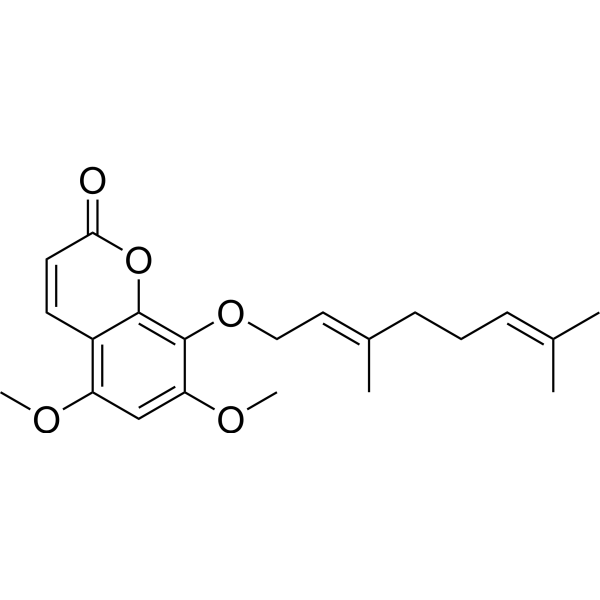
8-Geranyloxy-5,7-dimethoxycoumarin
CAS No. 1228175-65-2
8-Geranyloxy-5,7-dimethoxycoumarin( —— )
Catalog No. M30859 CAS No. 1228175-65-2
8-Geranyloxy-5,7-dimethoxycoumarin is a natural product of Toddalia, Rutaceae. The catalog number is TN3277 and the CAS number is 1228175-65-2. 8-Geranyloxy-5,7-dimethoxycoumarin can be used as a reference standard.
Purity : >98% (HPLC)
 COA
COA
 Datasheet
Datasheet
 HNMR
HNMR
 HPLC
HPLC
 MSDS
MSDS
 Handing Instructions
Handing Instructions
| Size | Price / USD | Stock | Quantity |
| 5MG | 594 | In Stock |


|
| 50MG | Get Quote | In Stock |


|
| 100MG | Get Quote | In Stock |


|
Biological Information
-
Product Name8-Geranyloxy-5,7-dimethoxycoumarin
-
NoteResearch use only, not for human use.
-
Brief Description8-Geranyloxy-5,7-dimethoxycoumarin is a natural product of Toddalia, Rutaceae. The catalog number is TN3277 and the CAS number is 1228175-65-2. 8-Geranyloxy-5,7-dimethoxycoumarin can be used as a reference standard.
-
Description8-Geranyloxy-5,7-dimethoxycoumarin is a natural product of Toddalia, Rutaceae. The catalog number is TN3277 and the CAS number is 1228175-65-2. 8-Geranyloxy-5,7-dimethoxycoumarin can be used as a reference standard.
-
In Vitro——
-
In Vivo——
-
Synonyms——
-
PathwayOthers
-
TargetOther Targets
-
Recptor——
-
Research Area——
-
Indication——
Chemical Information
-
CAS Number1228175-65-2
-
Formula Weight358.4
-
Molecular FormulaC21H26O5
-
Purity>98% (HPLC)
-
Solubility——
-
SMILES——
-
Chemical Name——
Shipping & Storage Information
-
Storage(-20℃)
-
ShippingWith Ice Pack
-
Stability≥ 2 years
Reference



-
JTK-109
JTK-109 is an inhibitor of hepatitis C virus NS5B RNA-dependent RNA polymerase inhibitor and inhibits G1b and G3a subgenomic replicons and recombinant enzymes.
-
Eliglustat hemitartr...
Eliglustat Hemitartrate, with an IC50 of 24 nM, is a specific, potent, oral active glucocerebral glycosidase inhibitor.Eliglustat tartrate shows good potency with an IC50 of 24 nM and specificity against the target enzyme.A novel inhibitor of glucosylceramide synthase (Genz-112638) and assessed its activity in a murine model of Gaucher disease (D409V/null).?Biochemical characterization of Genz-112638 showed good potency (IC(50) approximately 24nM) and specificity against the target enzyme.?
-
N-Biotinyl-1,6-hexan...
N-Biotinyl-1,6-hexanediaMine (Biotinyl hexylamine) is a synthetic intermediate that can be used to synthesize nanomedicines and chemotherapeutic couplers.



 Cart
Cart
 sales@molnova.com
sales@molnova.com


